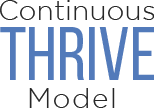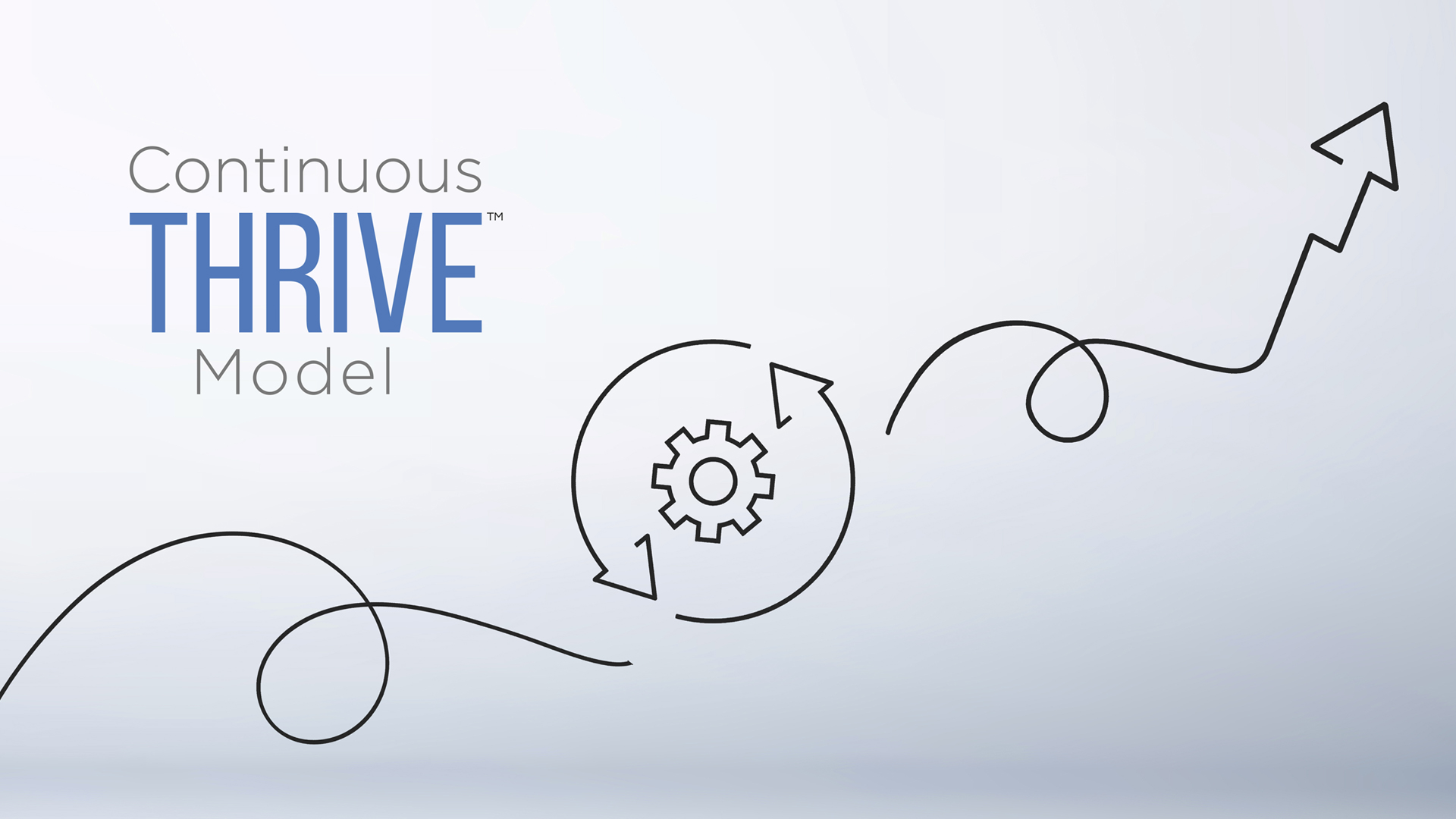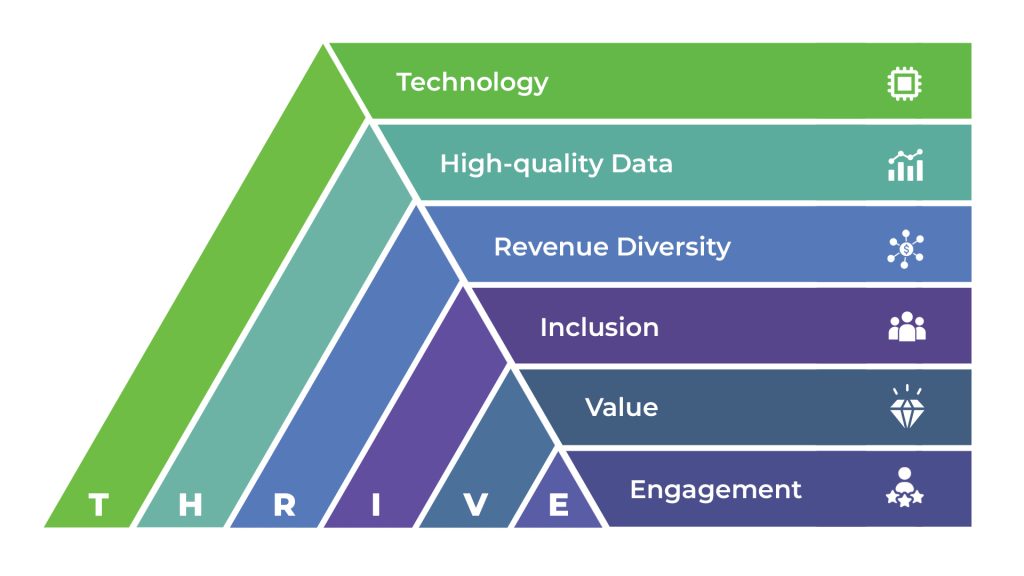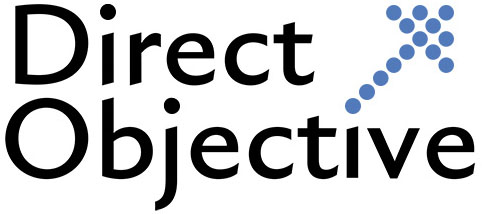A sustainable growth model requires a well-customized, well-implemented, and well-maintained execution. This is while many businesses already find themselves grappling with diminishing returns on investments, and increasing operational inefficiencies. Coupled with challenges like declining revenues, low customer retention, and disengaged teams, these obstacles can stall progress and limit the business growth potential.
Adopting a systematic model is a smart way to tackle these issues and move toward a more successful future. It empowers businesses to adapt, innovate, and excel and gives them a roadmap or blueprint outlining how their company can achieve continuous growth in the face of challenges.
The Continuous THRIVE Model is a customizable growth model that helps businesses reach their objectives. Using the model, organizations build a sustainable path toward long-term success by focusing on six pillars: technology, data, revenue diversity, inclusion, value, and engagement. Each of these aspects is addressed to identify the execution gaps so that a business can evolve from stagnation to thriving.
Now, is the Continuous THRIVE Model the game-changer approach your business needs? Let’s find out.
What Is a Growth Model in Business?
A growth model is a methodic framework that outlines the business’ execution plans to expand its operations, increase revenue, and achieve business success. It represents the mechanisms through which a company acquires and retains customers, highlighting the key processes and feedback loops that drive expansion. By mapping out crucial growth elements, an execution plan enables a business to identify and leverage the most effective strategies for scaling.
Common Challenges That Signal the Need for a Growth Model
Businesses often face hurdles that hinder their progress and limit their ability to grow sustainably. Identifying these symptoms is the first step toward implementing a model that can address them effectively and move forward. The following are the most important ones that you need to keep an eye on:
1. No or Little ROI from Marketing Efforts
Despite significant investments in marketing, the lack of measurable returns can be frustrating. Inefficient audience targeting, outdated strategies, and failure to use data-driven insights often lead to campaigns that fail to engage or convert.
2. Declining Revenues
Revenue decline often points to overreliance on limited revenue streams. Unsuccessful diversification of revenue sources or failure to capitalize on untapped opportunities can leave a business vulnerable to market shifts.
3. Lack of Product or Service Innovation
Innovation has become a crucial part of doing business and staying relevant. Businesses that haven’t introduced new products or services in years risk losing customer interest and falling behind more dynamic competitors.
4. Customer Retention Issues
High churn rates and difficulty retaining customers are red flags. These issues often stem from disengaged relationships, lack of personalized experiences, or unmet client expectations.
5. Operational Inefficiencies
Inefficient processes waste valuable resources and create bottlenecks that impact profitability and slow down growth. Outdated systems, poor communication, insufficient data, and redundant workflows are examples of operational inefficiencies.
6. Employee Disengagement
Disengaged employees lead to low morale and reduced productivity. Without clear goals, a sense of purpose, or alignment with the company’s vision, employees won’t have the motivation needed to drive business growth.
How the Continuous THRIVE Growth Model Helps
Our THRIVE model is designed to address the core challenges businesses face based on six pillars. Here’s how each component works:
- T for Technology: Technology is the backbone of modern business success. We leverage cutting-edge tools and technologies including AI and automation to enhance efficiency, streamline operations, and maximize marketing ROI.
- H for High-Quality Data: Access to reliable data is essential for making informed decisions. The model emphasizes collecting, analyzing, and utilizing high-quality data to identify trends, predict customer behaviour, and fine-tune strategies.
- R for Revenue Diversity: Over-reliance on a single revenue stream can be risky. The THRIVE model promotes revenue diversification by exploring new markets, products, and services to reduce risk, stabilize cash flow, and foster long-term financial stability.
- I for Inclusion: A culture of inclusion strengthens organizational cohesion as a driver of innovation and ensures that all voices are heard in the decision-making process. The THRIVE model encourages involving all stakeholders to foster creativity and shared ownership of success.
- V for Value Creation: Standing out in a competitive market requires offering something unique. Our growth model focuses on differentiated value propositions that resonate with customers and drive loyalty.
- E for Engagement: Success is built on relationships. Our growth model emphasizes the significance of engaging with both customers and employees. Through continuous education, skill development, and personalized interactions, businesses can nurture long-term loyalty, reduce churn, and maintain motivated audiences.
Is the Continuous THRIVE Growth Model Right for Your Business?
First, you need to ask yourself the following questions:
- Are we using technology effectively?
- Are we agile and competitive enough?
- Do we collect the right data?
- Are our revenue streams diversified enough to reduce dependency on one market or product?
- Are we leveraging the insights of diverse stakeholders?
- Are we offering clear, differentiated value to our customers?
- How strong are our relationships with employees and customers? Are they engaged?
So, is your business thriving?
If you answered “no” or hesitated on any of the above questions, your business can benefit from the Continuous THRIVE model. But why choose the Continuous THRIVE Model over others?
Holistic Approach
The Continuous THRIVE model sets itself apart through its holistic approach. While many frameworks focus on isolated aspects of growth such as revenue optimization or customer acquisition, the THRIVE model addresses every facet of a business’s execution, culture, and strategy through its six interconnected pillars.
Adaptability Across Industries
The model is uniquely customizable, enabling businesses across diverse industries to align the framework with their specific challenges and goals. By focusing on each of its pillars, the Continuous THRIVE model can be tailored to fit any business, regardless of size, sector, or market position. In fact, it was also used with associations and not-for-profit organizations.
A Focus on Sustainable, Long-Term Growth
Unlike other solutions, the Continuous THRIVE model emphasizes sustainable growth. It helps businesses build a solid foundation for enduring success and ensures growth is not just achieved once but maintained in the long run.
Ready to Ignite Your Growth?
Sustainable growth requires a unified approach — a model tailored to your business’s unique challenges and opportunities. The Continuous THRIVE Growth Model provides you with this comprehensive framework and the necessary tools to overcome obstacles, unlock potential, and achieve sustainable success.
Need more information to decide? Read 10 Frequently Asked Questions About the Continuous THRIVE Model.
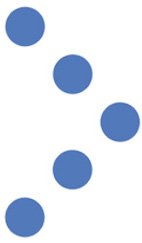
Concerned about persistent challenges that hold you back? Schedule your free consultation today to explore how our growth model can fit your business.
